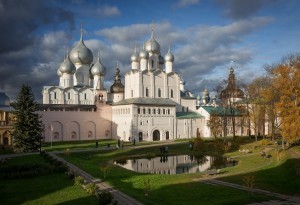Rostov Kremlin - Rostov's most famous sight!

The "visiting card" of tourist Rostov is the Kremlin with its five temples, the Dormition Cathedral and a complex of residential buildings, surrounded by powerful fortress walls. In its original purpose, the Kremlin was the residence of the bishops of the Rostov-Yaroslavl diocese. It can be divided into three independent parts. Central - this is actually the bishop's yard. In the northern part is the former cathedral square with the Dormition Cathedral, and in the south - the metropolitan garden.
Archbishop's Yard
Enclosed by high walls with beautiful towers, decorated with numerous heads of temples and tower tents, the Archbishop's Yard, now called the Rostov Kremlin, was founded in the 1660s in place of the old and much more modest Archbishop's building, from which only fragments of buildings are preserved.
The first temple built, a kind of cornerstone of the ensemble, was the Church of the Resurrection of Christ over the northern gate. This is not just a church, but a whole complex architectural complex consisting of a five-domed temple, a three-span gate, a gallery and two towers framing the gate. The Resurrection Church was supposed to perform the role of the Holy Gates in the complex of the Archbishop's Yard and was oriented outward to the Dormition Cathedral.
The second giant gate church is St. John the Divine, located above the western gate of the Kremlin. If the Resurrection Church was the first temple of the ensemble, then St. John was one of the last. The largest and most famous chamber in the Kremlin, the Red Chamber, adjoins the St. John's Church. Another remarkable temple of the Rostov Kremlin is the Saviour Church. This is the main, central temple of the Bishops' Yard, conceived by Metropolitan Iona Sysoyevich as a ceremonial church. Although it is located not in the center, but slightly covered by the building. Next to the Church of the Savior is the White Chamber, which was built at about the same time as the church. It is assumed that this complex was built exactly on the model of the Patriarch's Palace in the Moscow Kremlin.
Dormition Cathedral
The existing cathedral is already the fifth in a row at this place; before him in the center of the ancient city four more churches were changed. The first was the Cathedral of the Dormition of the Mother of God "from oak trees", wooden, founded in 991 under Prince Vladimir, one of the first cathedrals in Russia.
Built at the beginning of the 16th century, the Dormition Cathedral is a truly magnificent building worthy of being the central cathedral of Rostov, one of the main cities of medieval Russia. Its architecture is under the clear influence of the Dormition Cathedral of the Moscow Kremlin - probably the architects who built the cathedral, visited Moscow and carefully studied the metropolitan church. The powerful walls of the Dormition Cathedral in Rostov are divided by blades into three parts from the west and four from the north and south.
Initially, the chapters were somewhat different (perhaps helmeted), and in the XVIII century they were replaced by the current bulbous, covered with a share. During the Time of Troubles, the cathedral, as well as the entire city, was captured and ransacked by Tatars and Cossacks who were in the army of False Dmitry, and Metropolitan Filaret was captured and sent to the camp of the Tushino thief.
A luxurious baroque iconostasis, preserved to our days, was installed in the cathedral during the time Archbishop Joachim in 1736 after the next fire. The cathedral contains the graves of many Rostov princes and clergy, including the builder of the Rostov Kremlin, Metropolitan Iona Sysoyevich. During the replacement of the floors in 1884, the cancer of St. Leonty was discovered in the southern apse - a gift from Prince Andrei Bogolyubsky.
The complex of the Dormition Cathedral is a separate part of the present Rostov Kremlin, and much more ancient. However, the architects were able to put all other temples and walls with towers in such a way that they all became a single and harmoniously combined architectural ensemble, one of the most beautiful in Russia.
Belfry
The famous Rostov belfry was built at the cathedral in 1682-1677 in two stages. Of course, before it was a more ancient octagonal bell tower, the foundation of which was discovered by archaeologists to the south of the cathedral. The "belltowers" at the Dormition Cathedral were repeatedly mentioned in the Rostov annals. A little later, an extra pillar was added to the largest bell, and a bell weighing 33 tons was placed in it, named Sysoy in honor of the father of Metropolitan Iona Sysoyevich, the customer of the bells. And now in the repertoire of Rostov bells there is a special “Ringing with Sysoy.”
Join our tours and take a look at this amazing attraction:
Excursions - www.uvisitrussia.com/day-tours/tours-to-golden-ring/
Tours - www.uvisitrussia.com/tours-to-golden-ring/



